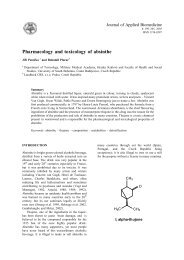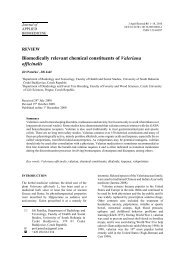Advances in biosensors: principle, architecture and applications
Advances in biosensors: principle, architecture and applications
Advances in biosensors: principle, architecture and applications
You also want an ePaper? Increase the reach of your titles
YUMPU automatically turns print PDFs into web optimized ePapers that Google loves.
1<br />
2<br />
3<br />
4<br />
5<br />
6<br />
7<br />
8<br />
9<br />
10<br />
11<br />
12<br />
13<br />
14<br />
15<br />
16<br />
17<br />
18<br />
19<br />
20<br />
21<br />
22<br />
23<br />
role <strong>in</strong> medic<strong>in</strong>e, agriculture, food safety, homel<strong>and</strong> security, bioprocess<strong>in</strong>g, environmental<br />
<strong>and</strong> <strong>in</strong>dustrial monitor<strong>in</strong>g (Luong et al. 2008). A biosensor consists of three ma<strong>in</strong> elements, a<br />
bioreceptor, a transducer <strong>and</strong> a signal process<strong>in</strong>g system (David et al. 2008). A biological<br />
recognition element or bioreceptor is generally consists of an immobilized biocomponent that<br />
is able to detect the specific target analyte (Kahn & Plaxco 2010). This biocomponents are<br />
ma<strong>in</strong>ly composed of antibodies, nucleic acids, enzyme, cell <strong>and</strong> etc. Transducer <strong>in</strong> the other<br />
h<strong>and</strong> is a converter. The reaction between the analyte <strong>and</strong> bioreceptor br<strong>in</strong>g about a chemical<br />
changes such as the production of a new chemical, release of heat, flow of electrons <strong>and</strong><br />
changes <strong>in</strong> pH or mass. The biochemical signal is converted <strong>in</strong>to an electrical signal by the<br />
transducer. Some of the commonly used transducers have been discussed <strong>in</strong> 3.0. Eventually,<br />
signal process<strong>in</strong>g where the electrical signal is amplified <strong>and</strong> sent to a microelectronics <strong>and</strong><br />
data processor. A measurable signal is produced, such as digital display, pr<strong>in</strong>t-out or optical<br />
changes. Figure 1 shows a schematic diagram of the typical components <strong>in</strong> a biosensor. There<br />
is a need for simple, rapid <strong>and</strong> reagentless method for specific determ<strong>in</strong>ation, both qualitative<br />
<strong>and</strong> quantitative, of various compounds <strong>in</strong> various <strong>applications</strong> (Shantilatha et al. 2003).<br />
Hence, it is paramount to have fast <strong>and</strong> accurate chemical <strong>in</strong>telligence which particularly<br />
conspicuous <strong>in</strong> human health care.<br />
Fig. 1.0. Biosensor operation.<br />
3





